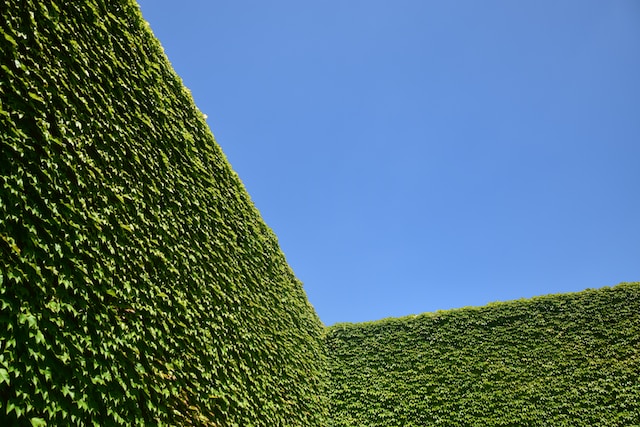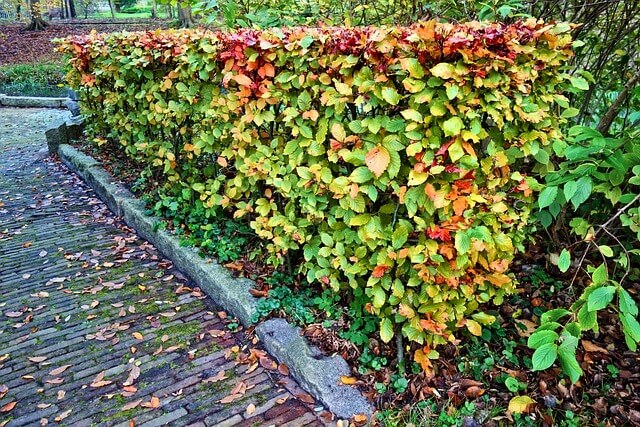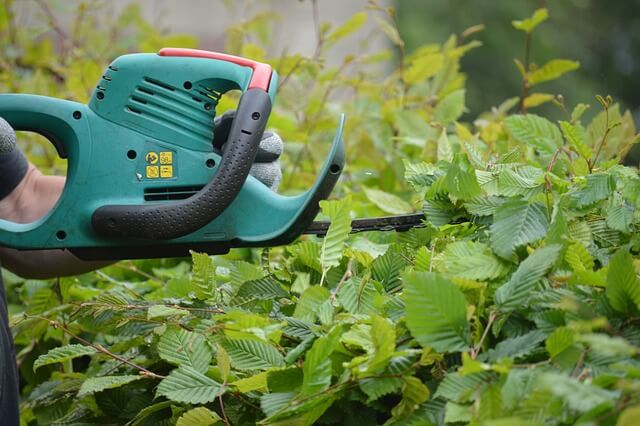Log in or create new account to save this product to your wishlist.

Pruning beech hedges: why, when & how?
Beech hedges offer excellent privacy and bring a lot of textural beauty into your garden. But pruning beech hedges is an artform, which - luckily - is quite easy to learn!
🌱 All important maintenance moments for your lawn during the year. Leave your email and we will send you the lawn calendar for free.
Enter your email
Receive the lawn calendar in the mail
Enjoy a green lawn all year round!

- Order by 2PM = shipped today
- 250.000+ satisfied customers!
- 60 day satisfaction guarantee
Beech hedges offer magnificent golden-green foliage that turns a stunning copper in the autumn. And while its structure offers privacy and shape to your outdoor space, your hedge can quickly grow out of control if left to its own devices. It’s time to get pruning those beech hedges!
- What is a beech hedge?
- Why is beech hedge pruning a good idea?
- When to prune your beech hedge
- Beech hedge pruning — a step-by-step plan
- Beech hedge pruning: expert tips
- What tools do you need for beech hedge pruning?
- Beech hedge pruning — the aftercare
- FAQs
Luckily, pruning a beech hedge is not — as they say — rocket science. Far from it. Nonetheless, it’s essential to get it right to ensure continued beauty and form in your garden.
This article is about beech hedge pruning, exploring why you should do it, identifying the right time to prune, and how to prune your beech hedge for the ultimate results.
Ready? Let’s get started.
What is a beech hedge?

There are two types of beech hedges found in the UK: the green beech and the red beech. Beech hedges are essentially the same plant as the beech tree, offering rapid growth (up to 50cm each year), so it’s generally considered safe to go a little nuclear with a beech hedge because it will bounce back quickly.
In fact, with the proper care and maintenance, a beech hedge can grow up to 10m in height and 5m wide. And a new plant will reach 2m within the first five years.
So: fast growers!
Why beech hedges are a popular choice for gardens
Beech hedges offer dense foliage, making them a popular choice for privacy and noise reduction. But they’ll need pruning occasionally; otherwise, these are relatively low-maintenance plants that thrive in various soils.
Plant your beech hedges during the autumn or winter when they’re dormant, although it’s OK to plant them in spring.
Why is beech hedge pruning a good idea?

Pruning helps maintain your plant’s health and appearance, helping them retain its shape and neat appearance.
And just like mowing a lawn, regular pruning promotes healthy growth while improving air circulation around the leaves and branches. This helps prevent pests and diseases.
And while it may seem counterintuitive, pruning actually helps promote bushier growth, increasing the bush’s density. This makes the beech hedge the perfect boundary for your garden, boosting privacy and preventing noise pollution from roads and noisy neighbours.
It’s OK to cut back a beech hedge hard — it will quickly return abundantly.
When to prune your beech hedge
Newly planted beech hedges don’t require pruning if there are plenty of side branches. However, if the plants are a touch on the sparse side, help to thicken them by cutting back the leading shoot and any longer shoots by up to one-third. Wait until winter or directly after planting.
Repeat this process in the second year if they’re still a bit leggy.
But:
From year three, you can trim the hedge’s sides in the 2nd week of August. Prune the top once the hedge has reached your favoured height. Aim for a 1m width at the base with a flat-topped tapered A-shape so that the whole plant enjoys plenty of sunlight.
Pruning an established hedge
Trim each August to maintain its size, allowing the bush to retain its new leaves for overwintering. They’ll go brown over the winter, but the leaves will stay on the branches, offering privacy during the winter.
If you miss the August prune, wait until spring (but be sure to avoid disturbing nesting birds).
Pruning an overgrown hedge
You can cut a beech hedge back hard in February during its dormancy, but wait if the weather is frosty or freezing.
If you intend to halve the height or sides, stagger it over two seasons rather than hacking it back all in one go. Cut the top and one side in the first year, leaving the other side to nature. Then, in the second year, cut the other side and the top.
If your hedge is slow to bounce back after the first pruning, leave the second pruning another twelve months if you can.
Beech hedge pruning — a step-by-step plan
Beech hedge pruning is pretty straightforward, but follow the correct techniques to prevent damage.
Step 1: Removing dead and diseased wood
Identify the new growth, and focus on the older wood. Remove dead or diseased wood, pruning back to the healthy wood.
Step 2: Cut cleanly
It’s essential that you get clean cuts on the ends of branches, so use sharp sheers or secateurs. Avoid leaving frayed edges, as these are more prone to infection.
Work from the bottom up, and ensure you cut at an angle so water from the other branches can drain away from the plant.
Step 3: Cut the top
Now, work on the top edge of the hedge, working your way across the entire plant. If working by eye, keep stepping back to ensure the top is level.
Alternatively, stretch a string along the top of the hedge at the height you want the plant to reach. Then, cut along the line, being careful not to cut through the string, of course.
Step 4: Neaten the sides
Now you’ve done the main cut, step back and ensure the sides are neat and even. Again, make any corrections from the bottom up.
In general, it’s better to leave the bottom of the hedge wider than the top — like an A-shape. That way, the entire hedge gets plenty of sunlight. However, if your plant is situated in a particularly sunny spot, you can cut it straight.
Step 5: Step back again
Finally, assess your pruning. Set back, and view the hedge from several angles. Cut back any twigs or stray branches you’ve overlooked.
Beech hedge pruning: expert tips

- Always taper the hedge, leaving it wider at the bottom than the top. This way, the lower branches won’t be shaded by the upper limbs. However, you can prune the sides straight if there’s plenty of sunlight.
- Use a bamboo stick to help guide your cutting to keep the sides tapered uniformly.
- Prune on a cloudy day. Never prune in full sun — it can burn the leaves and dry out the exposed branches where you’ve cut them. Also, inner leaves won’t have been exposed to direct sunlight yet — they’ll be extra sensitive to direct sun.
- Water your beech hedge before pruning. This helps protect the plant and makes it easier to cut through the branches.
- Spread a tarp across the ground underneath your hedges — it makes cleaning up afterwards much easier. Otherwise, you’ll be finding twigs across your lawn for weeks.
- Don’t allow your hedge to grow too high. Ideally, try to avoid climbing a ladder to get to the top of the plant. Use a motorised hedge trimmer for particularly large bushes.
- Fertilise your hedge just before pruning. Not only will it help the plant bounce back after a hard prune, but it will also make it less susceptible to pests and diseases.
What tools do you need for beech hedge pruning?
For the best results, have the right tools for beech hedge pruning.
These are the tools you need:
- A pair of pruning shears or a hedge trimmer
- Ladders
- Gloves
- Safety goggles
I recommend electric hedge trimmers for large bushes — it’s much faster, and you can be more accurate. It’s also OK to prune with a chainsaw, but it’s noisy, and the saw is heavy, so it can be more challenging to control.
A chainsaw will make light work of hard pruning, cutting through the trunk with ease.
Whatever cutting tool you use, make sure it has a sharp, clean blade to help protect your plants from disease or infection.
Beech hedge pruning — the aftercare
You may be glad to discover that your beech hedges will require very little attention after pruning.
But:
Ensure you water them regularly, especially when it’s hot and dry. They’ll need a little extra water after the prune, so be generous. Water the ground around the trunk rather than the leaves.
And all plants benefit from regular fertilisation — your beech hedge is no exception. Feed your hedge plants a couple of times a year, and they’ll repay you with beautiful green leaves and healthy growth for the rest of the year.
FAQs
You can prune your beech hedge up to twice a year. The right time to prune is the second week of August — this gives the plant plenty of time to recover before it goes dormant in the winter.
Beech hedges are pretty robust plants — they’re the same plant as the beech tree, after all. So, you can cut back a beech hedge pretty hard without damaging the plant. However, if you’re cutting the plant back by more than half, do it over two consecutive years — do the top and one side the first year, then the top and the other side the second.
To help your beech hedge grow back evenly after pruning, use a string line or a long, straight board as a guide to ensure you’re cutting the hedge straight and level. Take care not to cut too deeply into the hedge, as this can damage the plant and lead to uneven growth.
Ready to get pruning?
We hope you’re ready to get pruning, but if you have any questions, don’t hesitate to get in touch.
We love to hear from you and will reply as soon as we can.
Thanks for reading!
-
How to Grow Eucalyptus in British GardensWith a little love and care, eucalyptus trees can thrive in English gardens. Since they don’t germinate well without proper help, there are not considered invasive. So, there is no reason not to plant them if you enjoy their looks.Read more
-
Transform Your Garden with All-Year-Round Flowering PlantsDid you know you can enjoy blooming flowers even in January? With the right selection of all year round plants, there’s no need to wait until spring to add some colour to your garden.Read more
-
How to Create a Butterfly Garden: A Simple Guide for British GardensThe UK's butterfly population includes 59 different species. These beautiful winged creatures face a steady decline because of habitat loss, pollution and changing weather patterns. Your garden can become a vital link between nature reserves and natural habitats. Let’s explore how.Read more
-
Volcanic Rock Dust for Your Garden—Application and TipsDid you know that volcanic rock dust is a brilliant organic soil improver? This article explains exactly what it's good for and how to use it properly.Read more
-
How to Use Landscape Fabric ProperlyIf weeds or erosion in your garden are troubling you, landscape fabric might be the solution. We’ll explain how and when to use it properly, just keep on reading.Read more
-
Hostas: A Complete Care GuideIf you have a north-facing garden or some shady corners on your property, hostas are the plants for you. These green delights thrive particularly well in partial to full shade and require consistently moist soil to perform at their best.Read more
-
How to Grow Grapes in Your Garden: A Simple Step-by-Step GuideGrapevines produce some tasty fruits, but often they are simply grown for their gorgeous leaves. Whatever your motivation may be, we have a guide on how to grow grapes for you.Read more
-
Worm Composting Made Simple: From Kitchen Scraps to Garden GoldDid you know that a single pound of composting worms can devour half their body weight in waste every day? That's roughly twelve pounds of kitchen scraps transformed into garden gold each month! We will look at how to make this happen.Read more
Leave a comment
Your answer will be displayed on the site and the interested party will be notified by email.
Leave a comment
Have a question or want to share your experience? Leave us a comment.

- Order by 2PM = shipped today
- 250.000+ satisfied customers!
- 60 day satisfaction guarantee

- Order by 2PM = shipped today
- 250.000+ satisfied customers!
- 60 day satisfaction guarantee

- Order by 2PM = shipped today
- 250.000+ satisfied customers!
- 60 day satisfaction guarantee

🌱 All important maintenance moments for your lawn during the year. Leave your email and we will send you the lawn calendar for free.
Enter your email
Receive the lawn calendar in the mail
Enjoy a green lawn all year round!
















 Summer Deal! Get 15% off the
Summer Deal! Get 15% off the 




Comments (0)
There are no comments yet. Well then, what are you waiting for to
Be the first to write your comment!inaugurate this pretty page?
Do you have some comments?